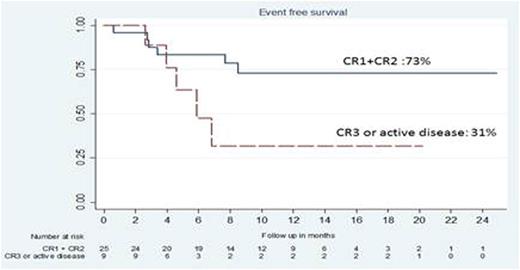Abstract
Introduction
The use of Haploidentical Transplantation (haploSCT) with pos-transplantation cyclophosphamide (PTCy) has become in a very good alternative for patients with acute leukemia who need a transplant but without a well matched donor, however, it is not clear what is the "best" conditioning regimen in this setting; on the other hand, fludarabine + melphalan (flu-mel) is a well-known preparative protocol, it has a good balance between toxicity and anti-leukemic activity. We explored the use of it plus the addition of 200-400cGy of total body irradiation (TBI) in a group of 34 patients with acute leukemia who were allografted with haplo peripheral blood stem cells (PBSC) and PTCy.
Methods and Patients
Donors were mobilized with filgrastim 5 mg/kg/BID for five days, the PBSC were collected with one or two large volume apheresis procedure. The conditioning consisted of melphalan 100-120 mgs/m2 administered on day -6, fludarabine 150 mgs/m2 split in 5 days, and 200-400 cGy of TBI added on day - 1 (Flu Mel TBI). All patients were given PTCy 50 mg/kg/day on D+3 and D+4, followed by ciclosporin and mycophenolate starting on day + 5. In all cases filgrastim was administered after transplant beginning on d + 6.
After a signed informed consent, 34 patients underwent to transplant; median age was 22 years (range 5-53), the diagnosis were: acute myeloid leukemia 11 patients, acute lymphoid leukemia 22 and 1 had myelodysplasia. 26.5% were in first remission (CR1), 47 % in second (CR2), and 26.5% in third or with more than 5% of blast in bone marrow (CR3). 5 out of 30 cases in remission had MRD positivity
Results
50% of patients received flu-mel +TBI 400 cGy, while the other half were given flu-mel + TBI 300 or 200 cGy. A mean of 12 million of PBSC/kg was infused. The neutrophil engraftment rate was 97%, median time to achieve 500 or more was 15 days (range 11-20), 3 patient died before d+ 100 without platelet recovery, the remaining had a self- sustained platelet count of 20.000 or more at an average of 15 days (range 12-48). Chimerism was available in all cases that survived beyond day + 100; all of them had full donor hematopoiesis.
The main toxicities were gastro intestinal; mucositis G II-III 35%, and two cases of hemorrhage, and bacteremia (30%). With a median follow-up for surviving patients of 11 months, the incidence of GVHD acute (GII-IV) and chronic extensive was 29.4 and 25% respectively. The transplantation related mortality was 17.4% while the rate of relapse was 14%. Causes of death were relapse: 4, sepsis: 4 fusariosis: 1, intestinal GVHD: 1.
Event was defined as death for any cause or relapse, the event free survival (Kaplan Meier) at 12 and 24 months was; 63% for the whole group, 73% for CR1+CR2 and 31% for patients in CR3 or with active disease (figure 1)
Conclusion
The use of fludarabine - melphalan plus 200-400 cGy of TBI as a preparative regimen previous to transplant of haplo PBSC with PTCy was associated to a fast and almost universal engraftment, acceptable toxicity and encouraging disease free survival showing a very good balance between tolerance and anti leukemic activity. It deserve more studies
Event free survival according remission
No relevant conflicts of interest to declare.
Author notes
Asterisk with author names denotes non-ASH members.


This feature is available to Subscribers Only
Sign In or Create an Account Close Modal